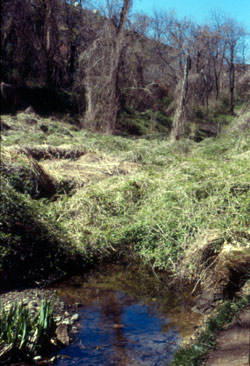
Threat
Dumbarton Oaks Park is one of the most significant designed historic landscapes in the National Park system. Because Beatrix Farrand's work at Dumbarton Oaks appears to retain more integrity than any other surviving Farrand landscape, the preservation and protection of the stream valley portion of her original design are all the more important. Although recently stabilized in limited ways, the stream, which flows through the valley, its related structures, and the park's naturalistic plantings remain threatened because of four factors:
one | Ever-increasing storm water flows caused by upstream urban and suburban development: Excessive storm water has significantly eroded the stream banks and the primary walking paths. It also has damaged the 18 stone waterfall dams, which were constructed in the stream as special water features. In the last eight years, NPS staff, Friends of Montrose and Dumbarton Oaks Park, The Georgetown Garden Club, the Student Conservation Association, Youth Conservation Corps, AmeriCorps, and the NPS Historic Preservation Training Center all have worked to stabilized water features, sandbag dam walls and stream banks, and annually remove sediment from the stream. However, these temporary measures are repeatedly overcome or washed out. The dams, architectural features, and stream bank paths and plantings cannot be stabilized for the long term and permanently restored until storm water originating outside the park is brought under control. The construction of a storm water detention pond is currently under consideration and waiting funding.
two | Deteriorated architectural features: The distinctive features of the park are in various states of decline and deterioration. The most serious degradation has occurred along both sides of the stream, where the primary walking paths and rustic stone structures are located. The structures include the 18 waterfall dams, two arbors, several benches, footbridges, two vintage pump houses, and the primary paths. As mentioned above, storm water runoff has undermined the area along and adjacent to the structures. Restoration of the structures is contingent upon the completion of an upstream detention pond that will reduce flows and water levels during storm events. Once the pond is constructed, restoration can begin on all the character-defining structural features. When the restoration of the paths and the structures is complete, walking, strolling, and viewing (the essential and primary visitor experiences in this historic designed landscape) can continued as Farrand originally intended.
three | Overgrown and invasive vegetation: With the assistance of the grounds staff of Dumbarton Oaks, as well as the Friends and Garden Club groups, the Forsythia Hill area was cut, weeded and replanted several years ago. However, the NPS continues to be challenged in its efforts to maintain the area and to provide the same level of attention on a regular basis. In response to this situation, NPS staff have developed a set of recommendations for preservation and restoration of all vegetation in Dumbarton Oaks Park , including the canopy and sentinel trees, shrub masses, groundcover, and drifts of herbaceous plants and bulbs. This multi-year project will also address removing all non-contributing and invasive plant materials, which compromise the spatial organization or have an adverse impact on other landscape features. Monitoring and maintenance of areas treated for plant removal will also be required prior to installation of the new plant materials. In addition, the project covers plant selection and installation. The plan, the removal program, and the planting will focus on the following areas located within the park: Beech Grove, slopes on Forsythia Hill and along the Hazel Walk, stream banks on the north and south sides, the sylvan pools, meadows, and the designed, transitional, and border woodlands.
four | Lack of established funding for routine and seasonal maintenance and for interpretation: The National Park Service recognizes the critical need to secure acceptable staffing levels for routine maintenance and for sustaining the park's restoration. In addition, a fully integrated interpretive program should also be incorporated into park operations.

